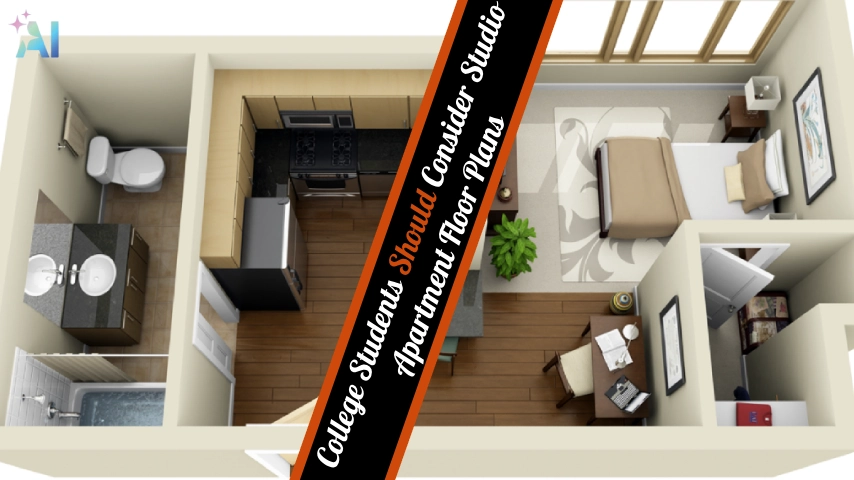Studio apartments are becoming increasingly popular among college students, and for good reason. These compact living spaces offer a unique blend of affordability, independence, and convenience that can greatly enhance the college experience. In this article, we’ll explore why college students should consider studio apartment floor plans and how they can make the most of these efficient living spaces.
Introduction
When you think of college housing, crowded dorms or shared houses might come to mind. But there’s another option that’s gaining traction: studio apartments. These compact living spaces are changing the game for college students, offering a perfect blend of independence and affordability.
Studio apartments are essentially one-room wonders. They combine your bedroom, living room, and kitchen into a single, open space. It might sound cramped, but with the right approach, these spaces can be surprisingly comfortable and efficient.
For college students, studio apartments can be a game-changer. They offer a level of privacy and independence that’s hard to find in traditional dorms or shared houses. Plus, they’re often more affordable than larger apartments, making them a smart choice for budget-conscious students.
What is a Studio Apartment?
Let’s break it down. A studio apartment is a self-contained living space where everything except the bathroom is in one room. It’s like having your bedroom, living room, and kitchen all rolled into one.
Typically, a studio apartment ranges from 300 to 600 square feet. That might not sound like much, but it’s all about how you use the space. The key features of a studio apartment include:
- An open floor plan
- A kitchenette or small kitchen area
- A sleeping area (not a separate bedroom)
- A bathroom (usually the only enclosed room)
Think of it as your own personal Swiss Army knife of living spaces – compact, but with everything you need.
Benefits for College Students
A. Affordability
Let’s face it, college isn’t cheap. Studio apartments can be a financial lifesaver. They’re often less expensive than larger apartments or even some dorm options. You’re paying for less space, which means lower rent and usually lower utility bills too.
But the savings don’t stop there. With a smaller space, you’ll be less tempted to buy unnecessary stuff. It’s like built-in spending control!
B. Simplified Living
Living in a studio apartment is like hitting the ‘easy’ button on adulting. Everything you need is within arm’s reach. No more trudging down long hallways to do laundry or cook a meal.
This simplified living can be a real time-saver. Less space means less cleaning and maintenance. And let’s be honest, who wouldn’t want to spend less time cleaning and more time studying (or Netflix-ing)?
C. Privacy and Independence
Craving some alone time? A studio apartment gives you your own private oasis. No more dealing with noisy roommates or shared bathrooms. It’s your space, your rules.
This independence can be a great stepping stone to adult life. You’ll learn to manage your own space, pay bills, and be responsible for your living environment. It’s like Adulting 101, but with training wheels.
D. Location Advantages
Studio apartments often have a secret superpower: prime locations. Because they’re smaller, they can often be found in desirable areas close to campus or in the heart of the city.
Imagine rolling out of bed and being just a short walk from your classes. Or having the best restaurants and entertainment right at your doorstep. That’s the kind of convenience a well-located studio can offer.
Space Optimization Strategies
Now, let’s talk about making the most of your compact castle. With a bit of creativity, you can turn your studio into a space that feels much bigger than its square footage suggests.
First up, multi-functional furniture is your new best friend. Think sofas that transform into beds, coffee tables with hidden storage, or desks that fold up against the wall. These pieces pull double (or even triple) duty, maximizing your space.
Storage solutions are crucial in a studio. Look for vertical storage options like tall bookshelves or over-the-door organizers. Under-bed storage containers can hide away seasonal clothes or extra linens. And don’t forget about the backs of doors – they’re perfect for hanging organizers.
Room dividers and partitions can help create the illusion of separate spaces. A strategically placed bookshelf or a hanging curtain can divide your sleeping area from your living space. This can make your studio feel more like a traditional apartment and give you a sense of distinct areas for different activities.
Financial Considerations
When it comes to your wallet, studio apartments often come out on top. Let’s break down the financial perks:
Rent comparison: Studio apartments typically have lower rent than one-bedroom apartments or shared houses. You might be surprised at how much you can save each month.
Utility costs: Less space means less to heat, cool, and light up. Your utility bills in a studio are likely to be significantly lower than in larger spaces.
Budgeting tips: Living in a studio can help you become a budgeting pro. With lower fixed costs, you’ll have more flexibility in your budget. Consider setting aside the money you save on rent for other priorities like textbooks, travel, or building your savings.
Remember, though, that prices can vary widely depending on location. A studio in the heart of a big city might cost more than a larger apartment in a less desirable area. It’s all about weighing your priorities and finding the best value for your needs.
Are Studio Apartments Suitable for Studying?
You might be wondering, “Can I really study effectively in such a small space?” The answer is a resounding yes – with the right setup.
Creating a dedicated study area is key. Even in a studio, you can carve out a space that’s just for hitting the books. A small desk in a corner, paired with good lighting and comfortable seating, can become your academic command center.
To minimize distractions, consider using noise-cancelling headphones or a white noise machine. Room dividers can also help create a visual barrier between your study space and relaxation areas.
And here’s a pro tip: your bed is for sleeping, not studying. Keeping your study area separate from your sleeping area can help you maintain better focus and sleep habits.
Social Aspects
Living in a studio doesn’t mean you have to become a hermit. It’s all about finding the right balance between privacy and social life.
While you have your own private space, many studio apartment complexes offer common areas like lounges, gyms, or rooftop terraces. These can be great places to meet other students and socialize without having to invite people into your personal space.
For hosting friends, get creative. Invest in a few folding chairs or floor cushions that you can easily store away when not in use. Or become the master of the picnic – take your gatherings to nearby parks or campus green spaces.
Remember, your studio is your home base, but your social life can extend far beyond those four walls.
Potential Drawbacks
Let’s be real – studio living isn’t all rainbows and butterflies. There are some challenges to consider:
Limited space for entertaining: Hosting large gatherings can be tricky in a studio. You might need to get creative or rely more on public spaces for bigger social events.
Challenges of combined living/sleeping areas: When your bed is in your living room (which is also your kitchen), it can sometimes feel like you’re always in the same space. This can be mentally taxing for some people.
But don’t let these drawbacks discourage you. Many students find that the benefits of studio living far outweigh these challenges. It’s all about finding what works best for you and your lifestyle.
How to Choose the Right Studio Apartment?
So, you’re sold on the idea of studio living. Great! But how do you choose the right one? Here are some factors to consider:
- Location: How close is it to campus? What about public transportation, grocery stores, or other amenities?
- Natural light: A studio with good natural light can feel much more spacious and pleasant.
- Storage options: Look for built-in storage or spaces where you can add your own storage solutions.
- Kitchen setup: Even if you’re not a master chef, having a functional kitchen area is important.
- Bathroom size: A cramped bathroom can make daily routines much less pleasant.
When apartment hunting, don’t be afraid to ask questions. How’s the Wi-Fi? What’s the noise level like? Are utilities included in the rent? The more you know, the better decision you can make.
Conclusion
Studio apartments offer a unique living experience that can be particularly well-suited to college students. They provide affordability, independence, and often prime locations, all of which can enhance your college experience.
Sure, living in a studio requires some adjustment and creative thinking when it comes to space usage. But the skills you’ll develop in managing your own space, budgeting, and living efficiently are invaluable life lessons.
Ultimately, whether a studio apartment is right for you depends on your personal preferences and lifestyle. But for many college students, these compact living spaces offer the perfect blend of privacy, affordability, and independence.
So, as you consider your housing options, don’t overlook the humble studio apartment. It might just be the perfect launchpad for your college adventure!





